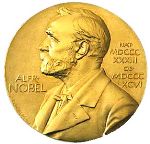Home > Press > The Nobel Prize in Physics 2007
 |
Abstract:
This year's Nobel Prize in Physics is awarded to Albert Fert and Peter Grünberg for their discovery of Giant Magnetoresistance. Applications of this phenomenon have revolutionized techniques for retrieving data from hard disks.
The Nobel Prize in Physics 2007
Sweden | Posted on October 9th, 2007The Nobel Prize in Physics 2007
The Royal Swedish Academy of Sciences has decided to award the Nobel Prize in Physics for 2007 jointly to
Albert Fert
Unité Mixte de Physique CNRS/THALES, Université Paris-Sud, Orsay, France, and
Peter Grünberg
Forschungszentrum Jülich, Germany,
"for the discovery of Giant Magnetoresistance".
Nanotechnology gives sensitive read-out heads for compact hard disks
This year's physics prize is awarded for the technology that is used to read data on hard disks. It is thanks to this technology that it has been possible to miniaturize hard disks so radically in recent years. Sensitive read-out heads are needed to be able to read data from the compact hard disks used in laptops and some music players, for instance.
In 1988 the Frenchman Albert Fert and the German Peter Grünberg each independently discovered a totally new physical effect - Giant Magnetoresistance or GMR. Very weak magnetic changes give rise to major differences in electrical resistance in a GMR system. A system of this kind is the perfect tool for reading data from hard disks when information registered magnetically has to be converted to electric current. Soon researchers and engineers began work to enable use of the effect in read-out heads. In 1997 the first read-out head based on the GMR effect was launched and this soon became the standard technology. Even the most recent read-out techniques of today are further developments of GMR.
A hard disk stores information, such as music, in the form of microscopically small areas magnetized in different directions. The information is retrieved by a read-out head that scans the disk and registers the magnetic changes. The smaller and more compact the hard disk, the smaller and weaker the individual magnetic areas. More sensitive read-out heads are therefore required if information has to be packed more densely on a hard disk. A read-out head based on the GMR effect can convert very small magnetic changes into differences in electrical resistance and therefore into changes in the current emitted by the read-out head. The current is the signal from the read-out head and its different strengths represent ones and zeros.
The GMR effect was discovered thanks to new techniques developed during the 1970s to produce very thin layers of different materials. If GMR is to work, structures consisting of layers that are only a few atoms thick have to be produced. For this reason GMR can also be considered one of the first real applications of the promising field of nanotechnology.
___________________________
Albert Fert, French citizen. Born 1938 in Carcassonne, France. Ph.D. in 1970 at Université Paris-Sud, Orsay, France. Professor at Université Paris-Sud, Orsay, France, since 1976. Scientific director of Unité mixte de physique CNRS/THALES, Orsay, France, since 1995.
www2.cnrs.fr/en/338.htm
Peter Grünberg, German citizen. Born 1939 in Pilsen. Ph.D. in 1969 at Technische Universität Darmstadt, Germany. Professor at Institut für Festkörperforschung, Forschungszentrum Jülich, Germany, since 1972.
www.fz-juelich.de/portal/gruenberg_e
Prize amount: SEK 10 million to be shared equally between the Laureates.
####
About Royal Swedish Academy of Sciences
The Royal Swedish Academy of Sciences, founded in 1739, is an independent organisation whose overall objective is to promote the sciences and strengthen their influence in society. Traditionally, the Academy takes special responsibility for the natural sciences and mathematics.
Nobel Prize® and the Nobel Prize® medal design mark are registered trademarks of the Nobel Foundation.
For more information, please click here
Contacts:
Erik Huss
Press Officer
Phone +46 86739544
mobile +46 706739650
Ulrika Björkstén
Scientific editor
mobile +46 702066750
Copyright © Royal Swedish Academy of Sciences
If you have a comment, please Contact us.Issuers of news releases, not 7th Wave, Inc. or Nanotechnology Now, are solely responsible for the accuracy of the content.
| Related News Press |
Memory Technology
![]() Utilizing palladium for addressing contact issues of buried oxide thin film transistors April 5th, 2024
Utilizing palladium for addressing contact issues of buried oxide thin film transistors April 5th, 2024
![]() Interdisciplinary: Rice team tackles the future of semiconductors Multiferroics could be the key to ultralow-energy computing October 6th, 2023
Interdisciplinary: Rice team tackles the future of semiconductors Multiferroics could be the key to ultralow-energy computing October 6th, 2023
![]() Researchers discover materials exhibiting huge magnetoresistance June 9th, 2023
Researchers discover materials exhibiting huge magnetoresistance June 9th, 2023
Announcements
![]() NRL charters Navy’s quantum inertial navigation path to reduce drift April 5th, 2024
NRL charters Navy’s quantum inertial navigation path to reduce drift April 5th, 2024
![]() Discovery points path to flash-like memory for storing qubits: Rice find could hasten development of nonvolatile quantum memory April 5th, 2024
Discovery points path to flash-like memory for storing qubits: Rice find could hasten development of nonvolatile quantum memory April 5th, 2024
Interviews/Book Reviews/Essays/Reports/Podcasts/Journals/White papers/Posters
![]() Simulating magnetization in a Heisenberg quantum spin chain April 5th, 2024
Simulating magnetization in a Heisenberg quantum spin chain April 5th, 2024
![]() Discovery points path to flash-like memory for storing qubits: Rice find could hasten development of nonvolatile quantum memory April 5th, 2024
Discovery points path to flash-like memory for storing qubits: Rice find could hasten development of nonvolatile quantum memory April 5th, 2024
|
|
||
|
|
||
| The latest news from around the world, FREE | ||
|
|
||
|
|
||
| Premium Products | ||
|
|
||
|
Only the news you want to read!
Learn More |
||
|
|
||
|
Full-service, expert consulting
Learn More |
||
|
|
||








